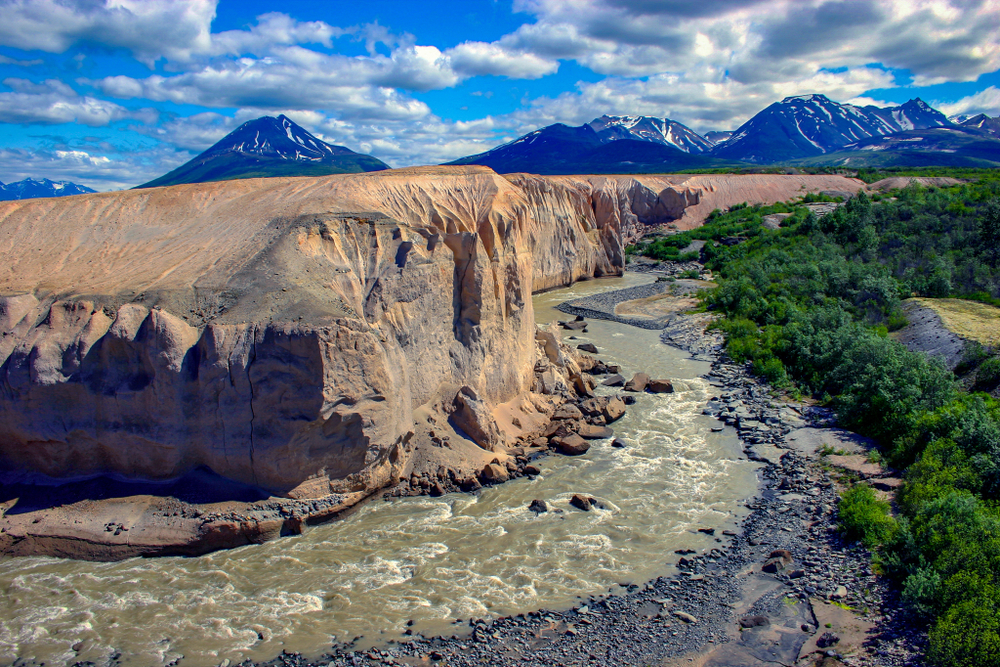 Mother Nature has always been one to create unexpected events that completely shift regions and create miles of morphed landscapes. From earthquakes to storms, everything can change in a single day. In 1912, the Katmai National Park region changed forever with the eruption of Mount Katmai and later-named Novarupta, which left what is now called the Valley of Ten Thousand Smokes. When you stay with us at Alaska’s Gold Creek Lodge, experience this incredible natural phenomenon by embarking on a guided adventure through the valley that still emits steady plumes of steam over 100 years after the largest eruption of the 20th century.
Mother Nature has always been one to create unexpected events that completely shift regions and create miles of morphed landscapes. From earthquakes to storms, everything can change in a single day. In 1912, the Katmai National Park region changed forever with the eruption of Mount Katmai and later-named Novarupta, which left what is now called the Valley of Ten Thousand Smokes. When you stay with us at Alaska’s Gold Creek Lodge, experience this incredible natural phenomenon by embarking on a guided adventure through the valley that still emits steady plumes of steam over 100 years after the largest eruption of the 20th century.
A Brief History
 In the 19th and early 20th century, the Ukak River Valley and Buttress Range looked completely different than the current-day landscapes. A once lush and thriving area that was used by Native Tribes as a trading route is now an ash and pumice covered landscape of charred remains, colorful mineral deposits, with unique land and water formations. In 1912, Mount Katmai erupted with such immense force that it sent smoke more than 20 miles into the sky and layered the landscapes and bodies of water in roughly six feet of a mixture of minerals, ash, and pumice. Though it is no Pompeii, Katmai Village and others were smothered in the plumes. The eruption is amongst the top five most massive eruptions in history and expelled 30 times more magma than that of Mount St Helens did in 1980.
In the 19th and early 20th century, the Ukak River Valley and Buttress Range looked completely different than the current-day landscapes. A once lush and thriving area that was used by Native Tribes as a trading route is now an ash and pumice covered landscape of charred remains, colorful mineral deposits, with unique land and water formations. In 1912, Mount Katmai erupted with such immense force that it sent smoke more than 20 miles into the sky and layered the landscapes and bodies of water in roughly six feet of a mixture of minerals, ash, and pumice. Though it is no Pompeii, Katmai Village and others were smothered in the plumes. The eruption is amongst the top five most massive eruptions in history and expelled 30 times more magma than that of Mount St Helens did in 1980.
In 1916 a botanist by the name of Robert F. Griggs was one of the first to lead an expedition into the valley and when he saw the vast amount of fumaroles sending pillars of steam into the sky. This vision that Robert F.Griggs had upon seeing the valley is what sparked the official naming of “The Valley of Ten Thousand Smokes.” In 1918, Mount Katmai and the valley was officially pronounced the Katmai National Monument and has since been the destination of adventurers near and far.
 What You Will See Today
What You Will See Today
The current state of Katmai National Park and Novarupta is much less smokey as most of the fumaroles have since cooled and extinguished. The only area that you can still catch steam rising into the air is Novarupta, a 200-foot dome-shaped formation that is the source of the massive eruption. The summit of Mount Katmai caved in to create a caldera that is roughly 2,000-feet deep and has since filled with water to form the Katmai Crater Lake that is clearly visible in satellite images from space. Along with scorched neighboring mountains, barren areas that rivers once flowed through, and a massive crater in the top of Mount Katmai, there are also two lakes that formed after the eruption. One is a muddy body of water that contains large amounts of silt and ash, while the other is a beautiful turquoise color. There are now pockets of oases where animals and lush plant life can be found with waterfalls and small lakes, but the majority of the land is almost desert-like in the sense of mostly barren landscapes. However, the views are nonetheless jaw-droppingly gorgeous.
Experience It All With Alaska’s Gold Creek Lodge!
When you come to Alaska’s Gold Creek Lodge, you will have the opportunity to explore the Valley of Ten Thousand Smokes with one of our exciting tours. Between float planes and a bus, you will have the chance to see this incredible natural wonder on a 23-mile drive or a challenging hike. Depending on your abilities, your guide will take you to some of the best vantage points of Katmai National Park and the Valley of Ten Thousand Smokes. There is no experience quite like it, and Alaska’s Gold Creek Lodge is ready to guide you through this fascinating area. You can call us for more information on transportation, what to bring, and any other questions you may have to begin planning your excursion today!


 What You Will See Today
What You Will See Today